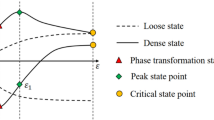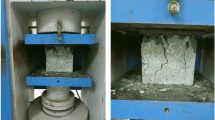Abstract
The shear properties of carbonate sand and structure interface are of significance for the engineering construction. The parallel paper (Rui et al. in Acta Geotech, 2020) focuses on the monotonic behavior of the interface between carbonate sand and steel. In this paper, by a series of shear tests on the interface between carbonate sand and steel, the evolutions of interface strength during cyclic interface shear were investigated. Further, the influences of cyclic amplitude, particle size, surface roughness and normal stress on the sand–steel interface shear behavior were discussed. Using a kind of transparent ring, the particle movements near the interface were observed to explain the mechanism during cyclic interface shear. The experimental results show that the shear zone appears near the interface, and is mainly composed of crushed fine particles and original particles. With lower steel roughness condition, the volume contraction is dominant in cyclic interface shear, while the dilation and contraction occur alternatively for higher roughness, which leads to higher interface shear strength. Compared with monotonic shear, the thickness of shear zone after cyclic shear is relatively small. Cyclic interface shear can lead to more fine particles, but less is embedded into the interface. It is found that under cyclic shearing, the interaction between particles and steel is enhanced, which is the main factor for promoting the interface strength, so interface strength in cyclic shear is higher than that in monotonic shear.


























Similar content being viewed by others
References
API (2000) 2A-WSD recommended practice for planning, designing and constructing fixed offshore platforms-working stress design. In: Twenty
Coop MR, Sorensen KK, Freitas BT, Georgoutsos G (2004) Particle breakage during shearing of a carbonate sand. Geotechnique 54(3):157–163
Datta M, Gulhati SK, Rao GV (1982) Engineering behavior of carbonate soils of India and some observations on classification of such soils. Geotech Propert Behavior Perform Calcareous Soils 777:113–140
DeJong JT, Frost JD (2002) A multisleeve friction attachment for the cone penetrometer. Geotech Test J 25(2):111–127
DeJong JT, Randolph MF, White DJ (2003) Interface load transfer degradation during cyclic load: a microscale investigation. Soils Found 43(4):81–93
Dejong JT, Westgate ZJ (2009) Role of initial state, material properties, and confinement condition on local and global soil-structure interface behavior. J Geotech Geoenviron Eng 135(11):1646–1660
Dietz MS, Lings ML (2006) Post peak strength of interfaces in a stress-dilatancy framework. J Geotech Geoenviron Eng 132(11):1474–1484
Donna AD, Ferrari A, Laloui L (2016) Experimental investigations of the soil–concrete interface: physical mechanisms, cyclic mobilization, and behaviour at different temperatures. Can Geotech J 53(4):659–672
Dove JE, Frost JD (1999) Peak friction behaviour of smooth geomembrane-particle interfaces. J Geotech Geoenviron Eng 125(7):544–555
Fakharian K, Evgin E (1997) Cyclic simple-shear behavior of sand-steel interfaces under constant normal stiffness condition. J Geotech Geoenviron Eng 123(12):1096–1105
Frost JD, Hebeler GL, Evans TM, DeJong JT (2004) Interface behaviour of granular soils. In: Proc. Earth and Space Conf., Houston, TX, pp 65–72
Hasanlourad M, Salehzadeh H, Shahnazari H (2008) Dilation and particle breakage effects on the shear strength of calcareous sands based on energy aspects. Int J Civ Eng 6(2):108–119
Ho TYK, Jardine RJ, Anh-Minh N (2011) Large-displacement interface shear between steel and granular media. Geotechnique 61(3):221–234
Holmes A (1978) Principles of physical geology. Sunbury-on-Thames, Nelson, London, p 730
Hyodo M, Aramaki N, Itoh M, Hyde AFL (1996) Cyclic strength and deformation of crushable carbonate sand. Soil Dyn Earthq Eng 15(5):331–336
Hyodo M, Hyde AFL, Aramaki N (1998) Liquefaction of crushable soils. Geotechnique 48(4):527–543
Kishida H, Uesugi M (1987) Tests of the interface between sand and steel in the simple shear apparatus. Geotechnique 37(1):102–106
Lings ML, Dietz MS (2005) The peak strength of sand-steel interfaces and the role of dilation. Soils Found 45(6):1–14
Martinez A, Frost JD (2018) Undrained behavior of sand-structure interfaces subjected to cyclic torsional shearing. J Geotech Geoenviron Eng 144(9):04018063
Mortara G, Ghionna M, Ghionna VN (2007) Cyclic shear stress degradation and post-cyclic behavior from sand-steel interface direct shear tests. Can Geotech J 44(7):739–752
Pra-ai S, Boulon M (2017) Soil-structure cyclic direct shear tests: a new interpretation of the direct shear experiment and its application to a series of cyclic tests. Acta Geotech 12(1):107–127
Rao KSS, Allam MM, Robinson RG (1998) Interfacial friction between sands and solid surfaces. Geotech Eng 131(2):75–82
Rui SJ, Wang LZ, Guo Z, Cheng XM, Wu B (2020) Monotonic behavior of interface shear between carbonate sands and steel. Acta Geotech. https://doi.org/10.1007/s11440-020-00987-9
Sadrekarimi A, Olson SM (2009) A new ring shear device to measure the large displacement shearing behavior of sands. Geotech Testing J 32(3):197–208
Salem M, Elmamlouk H, Agaiby S (2013) Static and cyclic behavior of North Coast calcareous sand in Egypt. Soil Dyn Earthq Eng 55:83–91
Shahnazari H, Rezvani R (2013) Effective parameters for the particle breakage of calcareous sands: an experimental study. Eng Geol 159(9):98–105
Sharma SS, Ismail MA (2006) Monotonic and cyclic behavior of two calcareous soils of different origins. J Geotech Geoenviron Eng 132(12):1581–1591
Wang XZ, Jiao YY, Wang R, Hu MJ, Meng QS, Tan FY (2011) Engineering characteristics of the calcareous sand in Nansha Islands. South China Sea Eng Geol 120(1):40–47
Wang XZ, Wang X, Jin ZC, Meng QS, Zhu CQ, Wang R (2017) Shear characteristics of calcareous gravelly soil. B Eng Geol Environ 76(2):561–573
Wei HZ, Zhao T, He JQ, Meng QS, Wang XZ (2018) Evolution of particle breakage for calcareous sands during ring shear tests. Int J Geomech 18(2):04017153
Yang ZX, Jardine RJ, Zhu BT, Foray P, Tsuha CHC (2010) Sand grain crushing and interface shearing during displacement pile installation in sand. Geotechnique 60(6):469–482
Zhang XY, Hu W, Scaring G, Baudet BA, Han W (2018) Particle shape factors and fractal dimension after large shear strains in carbonate sand. Geotech Lett 8:73–79
DeJong JT, White DJ, Randolph MF (2006) Microstructure observation and modelling of soil-structure interface behavior using PIV. Soils Found 46(1):15–28
Marks B, Einav I (2011) A cellular automaton for segregation during granular avalanches. Granul Matter 13(3):211–214
Marks B, Einav I (2015) A mixture of crushing and segregation: the complexity of grainsize in natural granular flows. Geophys Res Lett 42(2):274–281
Acknowledgements
The authors would like to acknowledge the supports from the National Natural Science Foundation of China (51779220, 51939010), the Zhejiang Provincial Natural Science Foundation of China (LHZ19E090003, LY15E090002), the Ministry of Industry and Information Technology with the research project in the fields of high-tech ships ([2016]22) and the Key Research and Development program of Zhejiang Province (2018C03031). All these supports are acknowledged.
Author information
Authors and Affiliations
Corresponding author
Additional information
Publisher's Note
Springer Nature remains neutral with regard to jurisdictional claims in published maps and institutional affiliations.
Rights and permissions
About this article
Cite this article
Rui, S., Wang, L., Guo, Z. et al. Cyclic behavior of interface shear between carbonate sand and steel. Acta Geotech. 16, 189–209 (2021). https://doi.org/10.1007/s11440-020-01002-x
Received:
Accepted:
Published:
Issue Date:
DOI: https://doi.org/10.1007/s11440-020-01002-x




